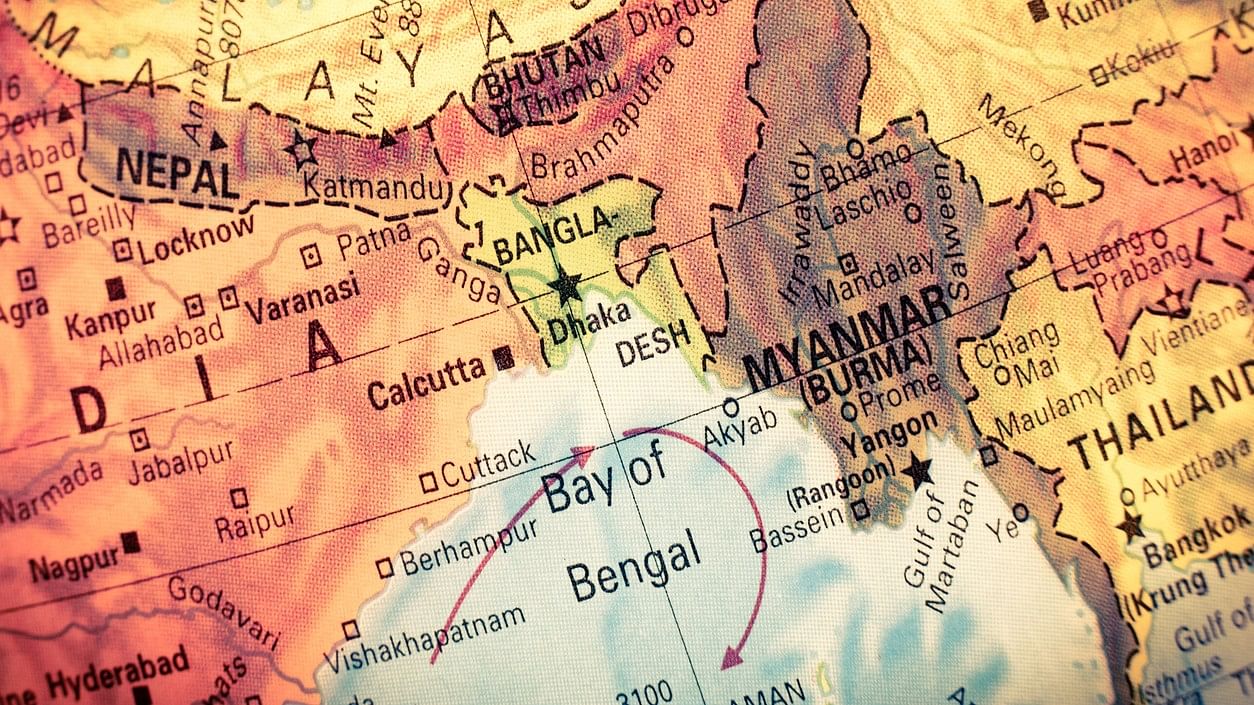
India, Bangladesh and Myanmar on a map.
Credit: iStock Photo
A missing connection in India’s responses to developments in Bangladesh after Sheikh Hasina Wazed’s flight from her country — still evolving for the most part — is Myanmar.
Some years ago, the makers of Indian foreign policy took a very insightful decision to create an exclusive division in the Ministry of External Affairs (MEA) dealing only with Bangladesh and Myanmar. This was done by breaking up a larger diplomatic unit which handled four neighbouring nations — Sri Lanka, Maldives, Bangladesh, and Myanmar.
The decision was not an easy one. For a country as large as India, and an aspirational global power, India has a small number of diplomats. China, Russia, and the United States, to cite examples, have many more. Intake into the Indian Foreign Service (IFS) has recently increased, but it will take at least a decade for these new recruits to be trained and equipped to deal with challenges in sensitive territorial divisions within the MEA. Besides, there was a question of turf: civil servants are loath to give up control. A larger geographical division in diplomatic work means greater power and influence for the officers concerned.
Given the rapidly unfolding scenarios in India’s neighbourhood making it increasingly dangerous in terms of security and foreign policy, the setting up of a separate Bangladesh-Myanmar division has paid dividends. It has made it easier for India’s official external affairs establishment to provide unvarnished and straightforward advice on these two countries to the political leadership in taking hard decisions.
However, any fallout of this laudable initiative is yet to impact India’s civil society, strategic community, and the media; especially the visual or social media. There have been no efforts to create public or political awareness that Bangladesh and Myanmar are inextricably linked. Developments in one of these countries can deeply affect the other, for better or worse. They can affect Indian interests as well.
The absence of such vital awareness can hamper the evolution of foreign policy in South Block, the MEA headquarters, and the Prime Minister’s Office. It can also spill over to North Block, where the Union Home Ministry’s important Border Management I&II Divisions are located.
Forces that are inimical to the rulers in Myanmar and to the secular and forward-looking political class in Bangladesh dominate the social media in South Asia: neither the junta in Myanmar nor the Awami League have been anywhere as imaginative as their rivals and have largely failed to counter the narratives of the latter.
Civil society organisations opposed to the rulers in Dhaka and Naypyidaw have a pervasive presence in South and Southeast Asia — especially in India and Thailand. Aung San Suu Kyi, Myanmar’s opposition leader, whose influence is now on the wane, has especially powerful backers across the board in India.
One of the myths created by civil society and mass media special interests, nudged by global powers which wanted regime change in Dhaka and Naypyidaw, is a canard about Chinese influence in both these capitals. The idea has been to dilute New Delhi’s critical support for rulers in both countries.
Such efforts can only be countered by raising awareness that what happens in Bangladesh can affect Myanmar and vice versa, and can impact India’s important interests in these two countries.
One example of disinformation of this kind is that China is building a road from its territory on the border with Myanmar, all the way to Myanmar’s border with Bangladesh. From time to time, Indians get worked up over this non-existent road. Just as they periodically get worked up over ports in Myanmar having a Chinese military presence.
Indian officials posted in Yangon, including defence officials who have reached the top of the Army hierarchy, have been given unfettered access — and officials from intelligence agencies in New Delhi posted at the Indian embassy — to Myanmar’s ports. They have faithfully reported the absence of China in these ports, but the rumours refuse to die down because of vested interests.
It is true that China wants connectivity to Bangladesh through land across Myanmar, but the junta has firmly and steadfastly refused China’s entreaties, incentives, and temptations over decades. India shares a tripoint both on the Myanmar-Bangladesh and the Myanmar-China borders.
The junta has been acutely aware that a China-Myanmar-Bangladesh road link has the potential to destabilise India with the influx of elements from all three countries which are ill-disposed towards New Delhi.
A failure to create awareness in India of the fallout of events in Bangladesh and Myanmar on each other, and on India, is prejudicial to India’s security.
(K P Nayar has extensively covered West Asia and reported from Washington as a foreign correspondent for 15 years.)
Disclaimer: The views expressed above are the author's own. They do not necessarily reflect the views of DH.